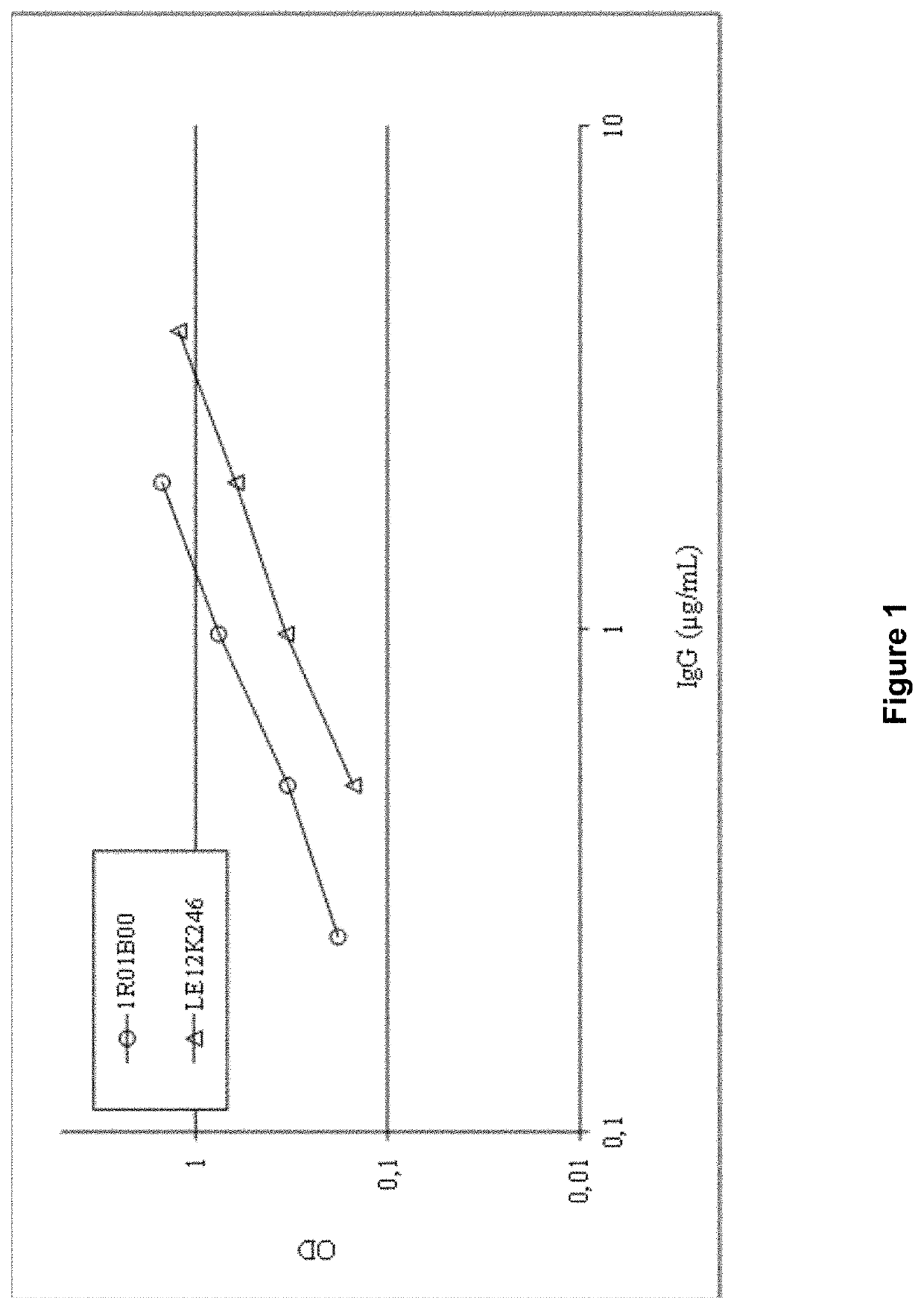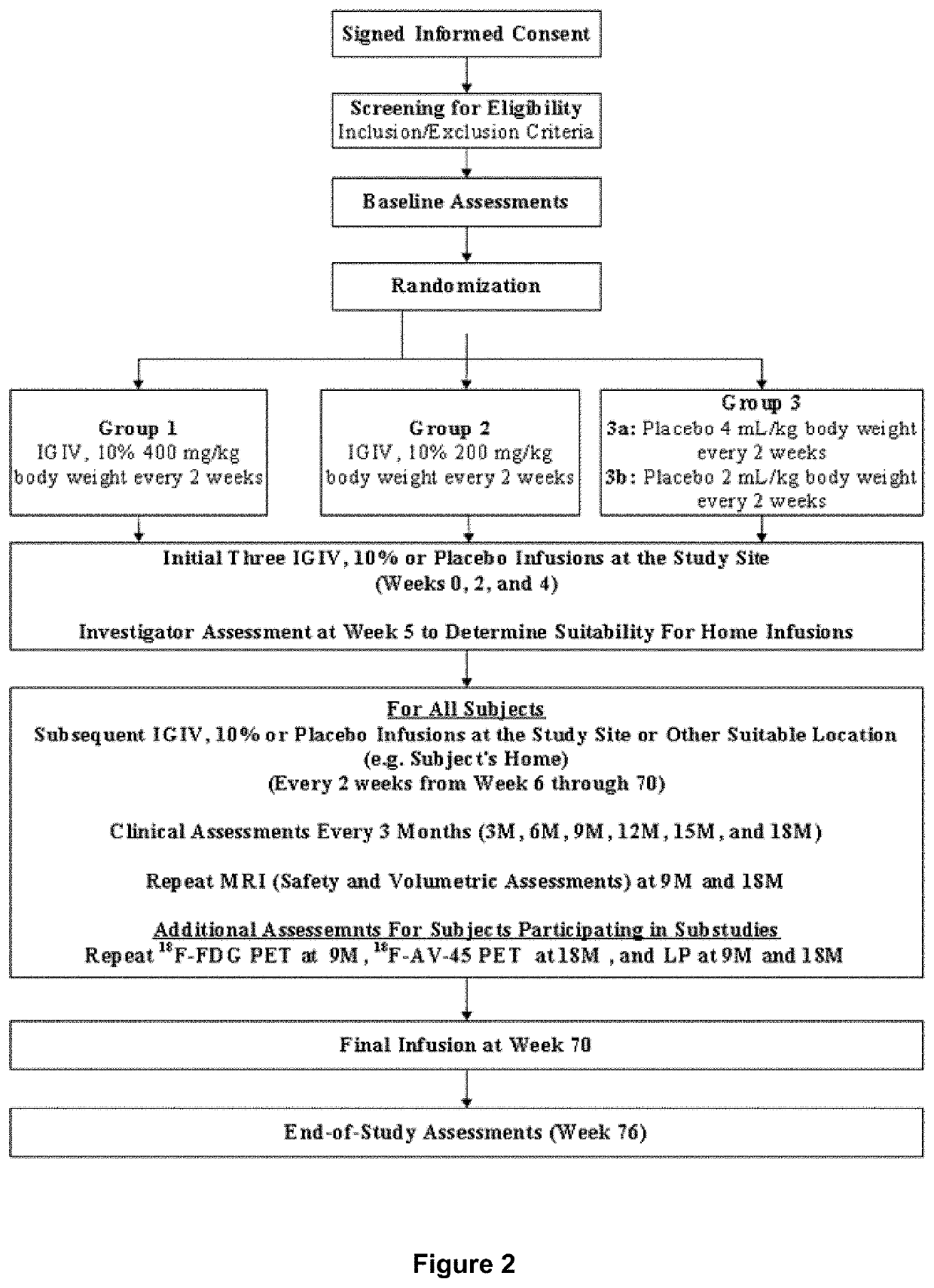Treatment of alzheimer's disease subpopulations with pooled immunoglobulin g
a technology of immunoglobulin and alzheimer's disease, which is applied in the field of treatment of alzheimer's disease subpopulations with pooled immunoglobulin g, can solve the problems of affecting the treatment effect of patients, the decline of most patients receiving these agents, and the lack of evidence to suggest, so as to slow down the progression of dementia
- Summary
- Abstract
- Description
- Claims
- Application Information
AI Technical Summary
Benefits of technology
Problems solved by technology
Method used
Image
Examples
example 1
of Anti-ApoE4 Antibodies in Pooled Human IgG
[0219]The apolipoprotein E (apoE) gene has been genetically linked to the onset of Alzheimer's disease (Ertekin-Taner N., Neurol Clin., 25:611-667 (2007)). Moreover, polymorph ApoE4 (a major isoform of the apoE gene, characterized by residues R112 and R158) has been indicated in the etiology of Alzheimer's disease, where it may play a role in differentially modulating amyloid-β (Aβ) levels through the formation of an ApoE4-Aβ complex. Several investigators, noting these correlations, have explored the use of anti-ApoE4 monoclonal antibodies for the treatment of Alzheimer's disease (Tai et al., J Biol Chem. 2013 Feb 22; 288(8):5914-26; Kim et al., J Exp Med. 2012 Nov. 19; 209(12):2149-56).
[0220]Anti-ApoE ELISAs were performed to determine if anti-ApoE4 antibodies are present in commercially available plasma-derived immunoglobulin G preparations. Briefly, the content of anti-ApoE4 antibodies in pooled human plasma (1R01B00) and a commercial ...
example 2
ation of Pooled Human Immunoglobulin G for Treatment of Alzheimer's Disease
[0221]A randomized, double-blind, placebo-controlled, two-arm, parallel study of the safety and effectiveness of intravenous immune globulin G (IVIG) administration for the treatment of mile-to-moderate Alzheimer's disease was performed. The primary objective of the study was To determine whether IVIG, 10% treatment either at a dose of 400 mg / kg body weight (BW) / 2 weeks or 200 mg / kg BW / 2 weeks for 18 months slows the rate or prevents the progression of dementia symptoms in subjects with mild-to-moderate Alzheimer's Disease (AD) as compared to placebo, as measured by the cognitive subscale of the Alzheimer's Disease Assessment Scale (ADAS-Cog) and the Alzheimer's Disease Cooperative Study (ADCS)-Activities of Daily Living (ADL).
[0222]Other objectives of the study included: to whether IVIG, 10% treatment either at a dose of 400 mg / kg BW / 2 weeks or 200 mg / kg BW / 2 weeks for 9 months results in a significantly slo...
example 3
of IVIG Administration in Subjects with Moderate Alzheimer's Disease
[0244]The results of the IVIG treatment study presented in Example 2 were reevaluated using modified criteria for defining mild and moderate Alzheimer's disease. It was found that by increasing the power of the study (e.g., the number of individuals in the moderate disease cohort) by including additional patients with advanced Alzheimer's disease that were originally classified as having moderate disease, that high dose IVIG treatment of subject with moderate disease has a statistically significant effect.
[0245]The study presented in Example 2 defined subjects with moderate Alzheimer's disease as having an MMSE score of 20 or less (e.g., effectively MMSE=16-20, inclusive because no individuals having an MMSE score below 16 were admitted to the study). Initial cognitive assessments of subjects having moderate disease, using the ADAS-Cog and 3MS cognitive examinations, suggested a positive trend in slowing the progres...
PUM
 Login to View More
Login to View More Abstract
Description
Claims
Application Information
 Login to View More
Login to View More - R&D
- Intellectual Property
- Life Sciences
- Materials
- Tech Scout
- Unparalleled Data Quality
- Higher Quality Content
- 60% Fewer Hallucinations
Browse by: Latest US Patents, China's latest patents, Technical Efficacy Thesaurus, Application Domain, Technology Topic, Popular Technical Reports.
© 2025 PatSnap. All rights reserved.Legal|Privacy policy|Modern Slavery Act Transparency Statement|Sitemap|About US| Contact US: help@patsnap.com



